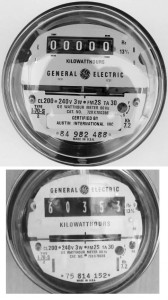 You can purchase verified electromechanical analog electric meters at Electrahealth.
You can purchase verified electromechanical analog electric meters at Electrahealth.
These are refurbished analog meters with a numerical readout (not digital). The photo here is not a direct representation of the meters they sell, but very similar to their model.
Is having your own electric meter changed a crime? Is it “tampering” as PG&E and other utilities have told people? Basically, no, it does not constitute “tampering”, i.e “a misdemeanor crime which requires the specific intent to get the utility service for a lower cost.”
Shaun Kranish who runs Electrahealth, says they are going a brisk trade in these meters. He wholeheartedly supports people being educated about their electricity, and people having choices. If your utility refuses to give you an analog meter, get one easily and quickly at Electrahealth.

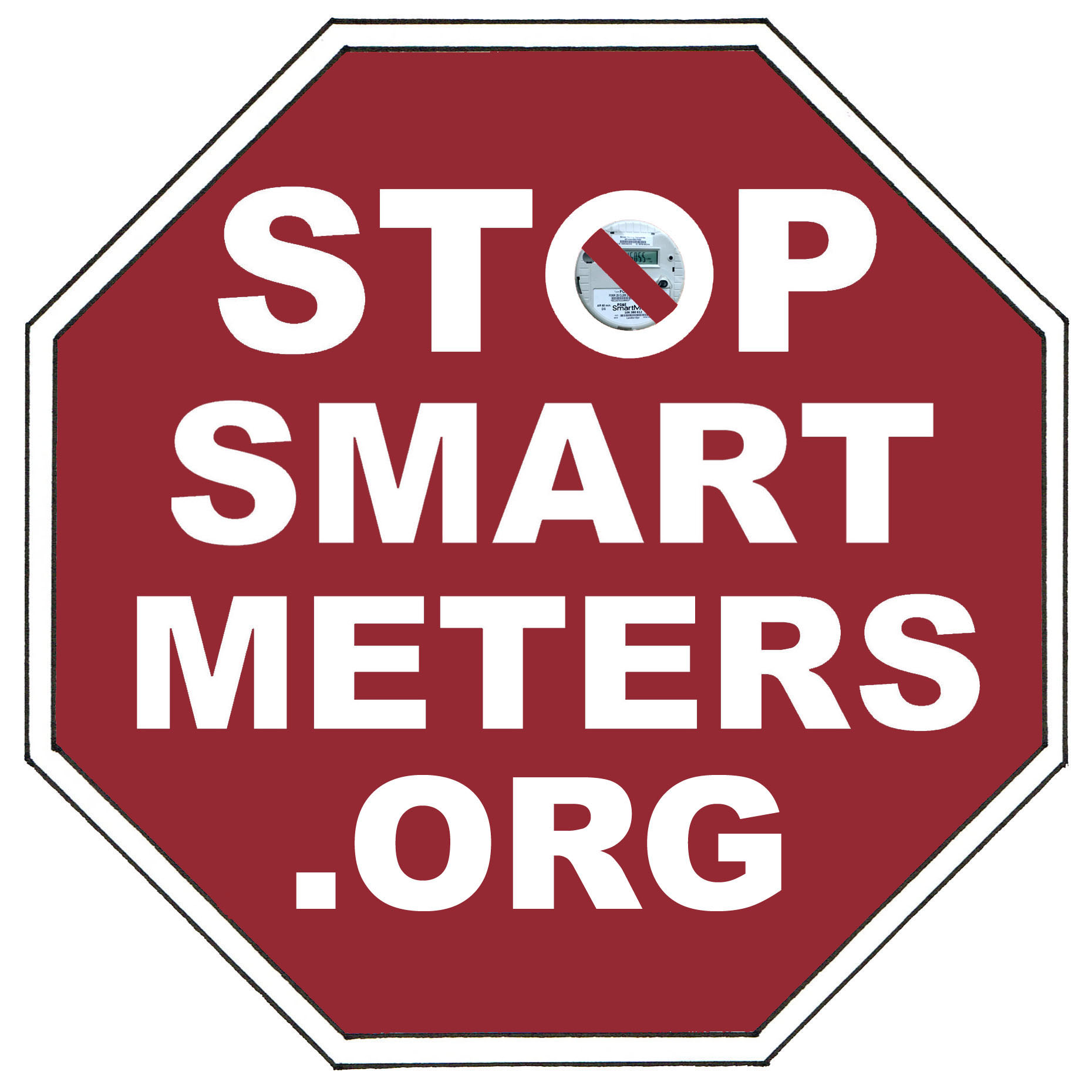
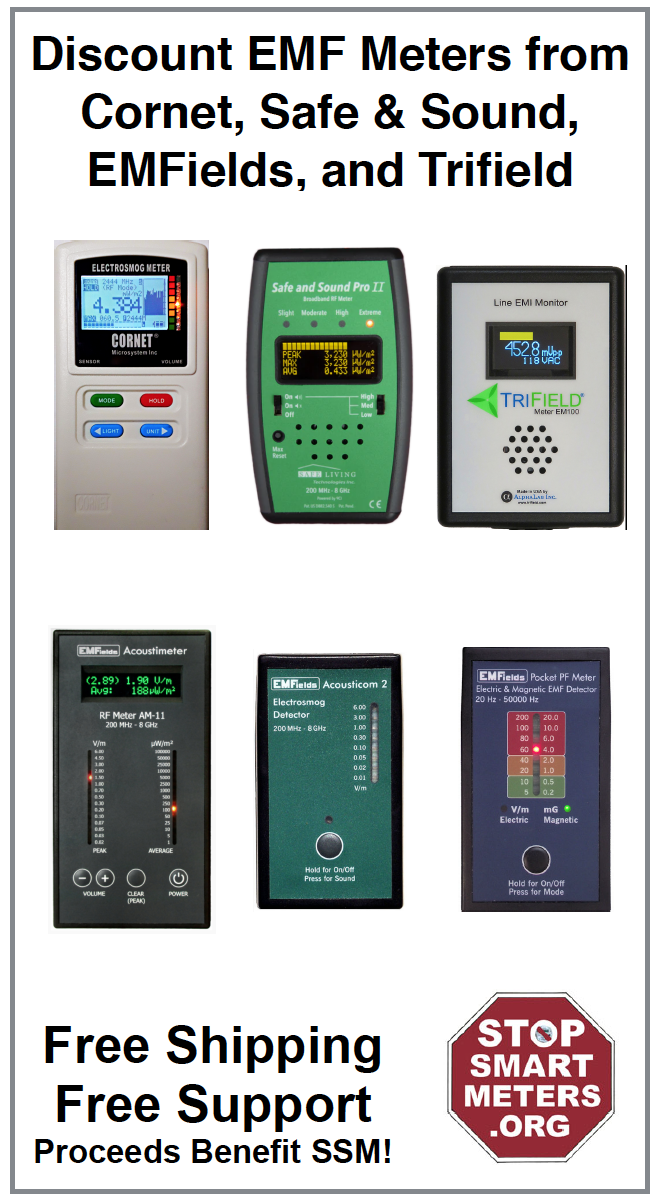
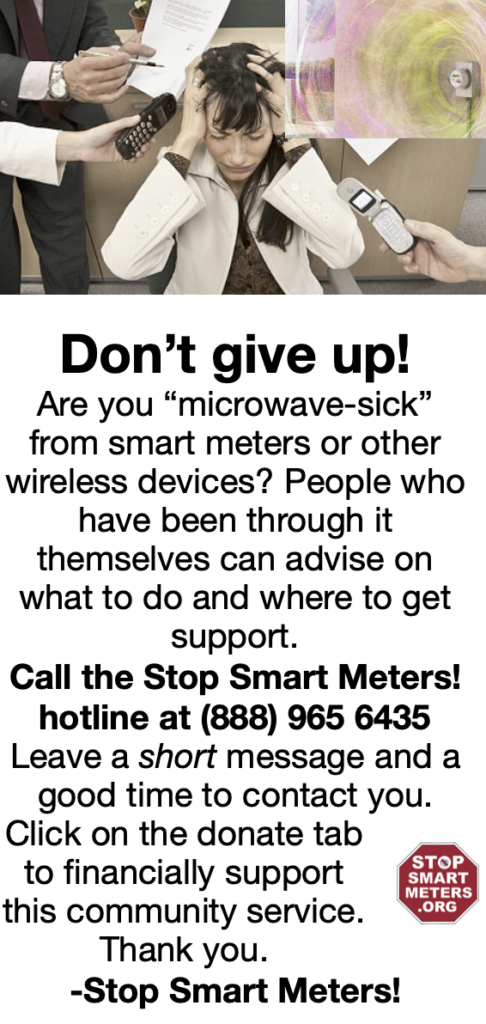
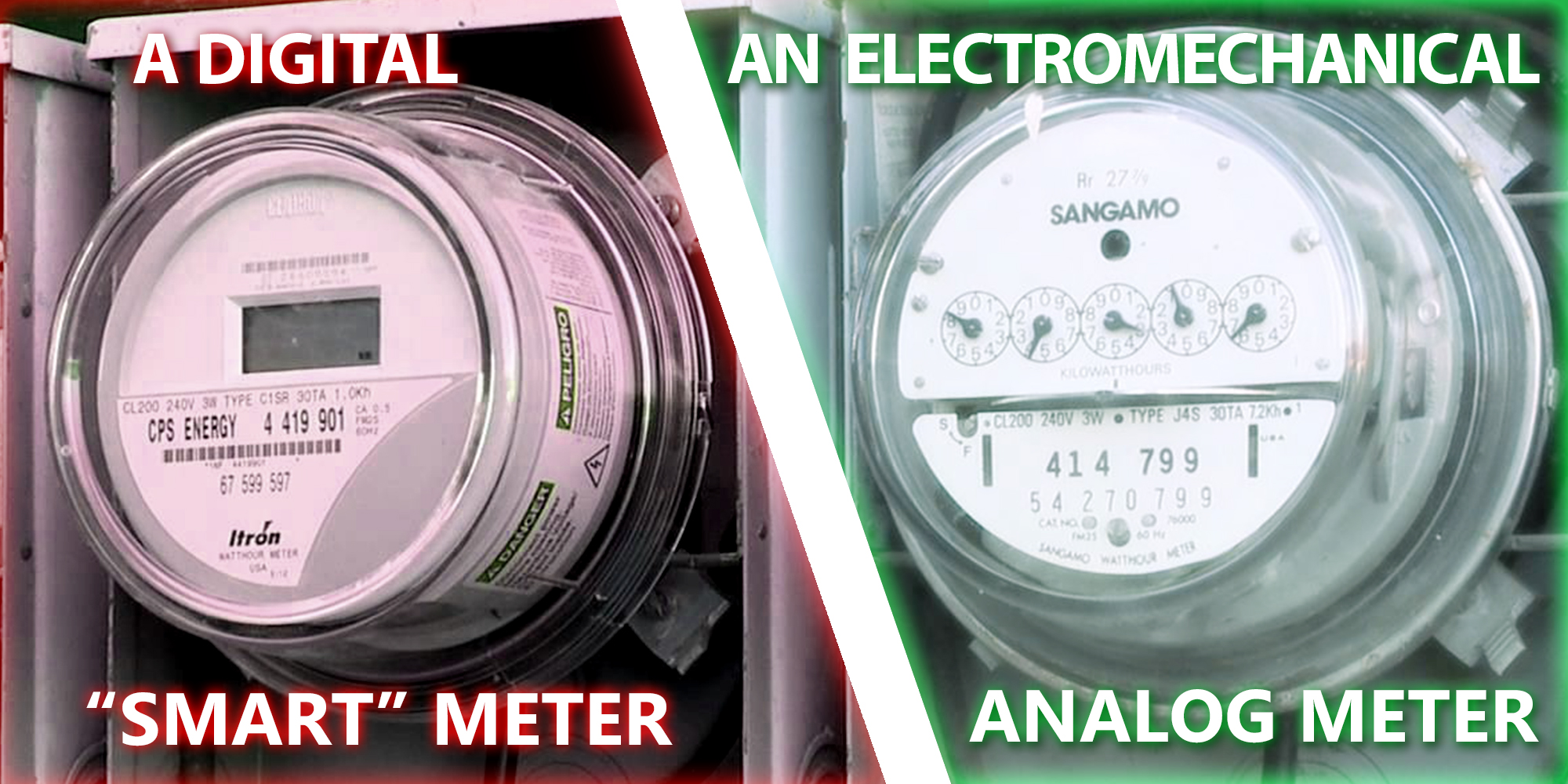



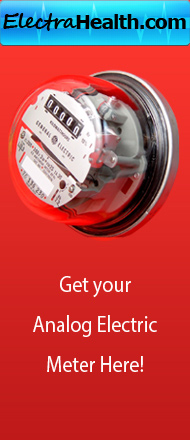
I want to add that changing out a meter is very simple and quick. If you are changing out a “smart” meter then there is nothing at all to worry about. If a new meter has been successfully installed in an existing socket by Wellington, and it has not arced and started a fire yet, you are good to go.
The most important thing that I want to stress is to turn off all loads being fed by the meter before removing and replacing it.
Most buildings have a service disconnect located after the meter, it could be a fused disconnect switch or a circuit breaker, turn that off first. If there is no service disconnect, then go to the main load center panel being fed by the meter, there will be a main breaker inside that panel, turn it off. If there is no main breaker, turn off all the individual circuits inside that panel.
The reason for this is when a load is disconnected, it creates an arc, no load, no arc.
Make sure to take a picture of the reading on the meter that you are removing, and also write it down for your meter reader, because the new meter will be zeroed out.
Carefully snip the seal that has your meter number and a PG&E serial number, pull the seal out and put it back in the ring after you change out the new meter. I have done this hundreds of times in my career, and I have never had one problem in doing so.
Your meter reader will probably recognize that you have a different style of analog meter, but they don’t care, and most likely will not report it, they are concerned about keeping their jobs, and the more analog meters still in use , the better.
If you have to do it when it is raining, put up an umbrella the night before, and then put out a dry wood palate or some kind of non-conductor on the ground.
Wear 2 sets of gloves, rubber gloves under good leather gloves (dry of course).
When you remove the “smart” meter from its socket, you might have to gently wiggle it out of the jaws. Then once removed, simply insert the new analog meter carefully (right side up, please) into the jaws, you might have to push hard to do this. Make sure that the new meter is completely snug in the socket, test it by trying to wiggle it, it should not move at all one way or the other. Then you are good to replace the aluminum ring and seal and party on, you are pau hana (done with work). Make sure to remember to turn back on the feed to the load center, the main breaker in the load center, or all the individual circuits in the main panel.
Keep in mind that even though these new radio meters are using your electricity to transmit radio signals 24/7, they only transmit a packet of total usage data every 4 hours. So depending on when you you remove the transmitter, if your meter is actually connected with a data collector, ( most are not, and still need to be read monthly by a meter reader), then PG&E will see a drop of data signal. That is the wonderful feature of the new radio meters, that if working, they can sense a power interruption in a 4 hour block, and will consider it an outage or removal of the transmitter.
That is one of the biggest jokes of all about the new meters, that they can detect power outages. When there is an outage at my house, I am on the phone within one minute to report it. The operator asks if I have any information about what might have caused the outage like : trees, wind, exploding transformers or cut out fuses.
It is the FIFO deal with PG&E, first reported gets to be on the top of the list, and chronologically after that. That can be important in a major storm.
Another tip from a PG&E lineman, if you see any downed power lines, that is the number one priority, and that will get the fastest response.
Thanks for the detailed technical information on installation. That covers it very well.
One important point, when you cut the power using the main breaker, you are only turning off the power going INTO your house, not the power coming in from the power pole / power grid.
So be aware that the power is still coming in on the upper two contacts (for most homes and situations). That’s why you want to use rubber gloves and wear some well insulated shoes just to be safe. You also should be aware of what you are touching, and touch nothing else except the meter when installing it.
There are a few videos on youtube of people installing meters, search for them and get an idea of how it goes. Smart meters being installed are there also.
Good luck and the proper response from the power company once you notify them of the change should be to send out a guy to re-do the little tamper seal, that’s all. That of course would be in a sane world.
Obviously if you turn off a circuit breaker after the meter, the power is still coming into the meter, but thanks for reminding some people.
I really don’t recommend that people do it in wet weather, only if it is very critical and it’s the middle of winter.
Even in dry weather, I put down cardboard or wood on the ground for safety’s sake. There could be an irrigation system and even if the ground looks dry, it may not be.
When you pull the meter out of it’s socket, take a look at the jaws (BUT DO NOT TOUCH) to check them out for rust or signs of arcing (blackened), and also look to see that they are not damaged or misaligned in any way. If you see any obvious damage, you can buy a new meter socket from Real Goods for around $30. I recommend hiring a licensed electrician to change out a meter socket.
And it would be wise to sport goggles when working near live electrical panels.
This is slightly off-topic but hope you can provide answersto my questions
I just purchased an old electric meter lamp from an antique store. It is an old Westinghouse meter and it actually works when the lamp is plugged in. The dial even spins when the light is turned on. Unlike the ones listed on Ebay, it is not just a meter mounted on a wood post with a lamp wired through the back. Instead, this craftman drilled a hole in the glass cover and ran the lamp post though the hole.
First question: is it dangerous? I joked with a friend that it looked like a bomb but, after reading your precautions regarding electric meters, maybe it isn’t a joke afterall.
The meter spins fairly fast and the lights sometimes stay solid red. Is this lamp really using that much energy? I don’t really want my power bill to skyrocket over burning a 60 watt bulb.
This lamp could be a great conversation piece so I would love to use it…. but I’m a little hesitant. Please advise. Thanks.
Are you allowed to change digital to analog in any state, legally, particularly in Michigan? Do you have to contact, in my case, DTE, before or after installation? Is the power company allowed to confiscate your analog property? I hate the digital reader, for obvious reasons, and I am seriously going to speak out about this major problem, worldwide.
I have called a number of different electrician companies looking for a certified electrician to swap-out my “smart” meter for an analog meter and they are all saying the same thing that:
1.) They will not perform that task,
2.) I have to go through “ONCOR,” the service provider, to perform that task,
3.) That anyone other than the service provider that performs that task of swapping the “smart” meter with an analog meter will lose their electrician’s license and it is illegal, etc.
What do I do now???
I forgot to mention that I am in Texas.
Here is a link to a secondary legal source.
http://www.statutes.legis.state.tx.us/Docs/UT/htm/UT.43.htm
Does the manufacturer of either the original analog meters or the new meter specify any requirement of De-Oxy compound on Aluminum or dissimilar metal tangs? If so, is this a step that may be missed by ‘competent’ installers? If so, it could help explain some fires.
Don’t take my word for it, RESEARCH it. While you’re at it, research the Dual-Base Meter.
http://www.kgoradio.com/Article.asp?id=1740790&nId=0&spid=33179
Anti oxidant compound is usually used on connections (splices and lugs) that use aluminum wire. Most meter enclosures have a copper bus bar and jaws, and the meter has copper tangs. So it is not required to use NoAlox on meter installations.
The triplex that is swung in free air to the weather head is almost always aluminum wire, but out on the coast everything is copper, because of corrosion problems caused by the salt air. It is prudent to use NoAlox on copper splices done in coastal areas, but the meter is usually in a NEMA 3R raintight enclosure, so I would say no, don’t use on a meter install.
Hi Redi,
Do you happen to live anywhere close to Orange county CA? I plan on getting an analog meter reinstalled and you seem to know a lot about it. I would love to hire you.
Thank you,
Kara
Pingback: How to create a healthier world — what you can do if you have these common appliances « Burbank ACTION
Thank you for this amazing site. There is one question that I can’t seem to find an answer to online. A Smart Meter was installed on our home two days ago. I plan to remove the meter and replace it with an analog meter but until then. How far away should I be sleeping from the meter? My bedroom wall is where the meter sits. So I sleep 10-12 feet from it and my toddler sleeps 15-20 feet from it. Also once I do remove the meter my neighbors meter is right by this same wall which is only an additional 5-7 feet from where we sleep. Will we still be exposed? Thank you, Kara
Hi Kara,
No I don’t live anywhere near Orange county, I live in Marin county (PG&E territory).
I wish I could help you, but I’m sure that you could find a licensed electrician down in your area that could take care of your meter change out.
If you solicit someone, I suggest that you offer to pay the person in cash, and that you will promise not to give up his or her name to anyone else related to the utility company.
If you and/or others in the house are electro sensitive, you should move your bed as far as you can away from the meter. As for your neighbors meter being only 25 feet away, that could cause you problems too. You should work on them to have it removed, or, when you have yours removed, offer the neighbor to have theirs done at the same time.
Things are a little slow for the skilled specialty trades now.
The cost of a refurbished utility watt hour meter made by Schnieder Electric is around $50 to $75 at an electric supply house. I would charge around $250 to do a simple change out within 5 miles of my shop, but if I was requested to change out 2 meters at the same location, I would charge $375 for 2. This is granted that no other unforeseen work is needed.
Bueno Suarte,
RKw
And you wonder why people change their own meters. With rip off artists like you running around.
Here’s another source for analog meters at a lower cost:
http://www.hialeahmeter.com/siphwame.html
Pingback: Defend Your Analog Meter, Part VI | Stop Smart Meters!
Here is another site for purchasing analog meters and all the steps for installing, notifying your gas and electric company, etc. Good luck; we are making this a big project in San Diego in January
http://www.refusesmartmeters.com/page29.html
tried this web site, when I click on Buy Now–it wont work
Hey All,
Here in the Great White Corporate-dominated fascist-government-run North, our supposedly “public” utility BC Hydro (now under the thumb of big private corporate energy hacks) is going ahead with replacing analog with so-called “smart” (that’s a laugh) meters.
To try to get around the legal requirements that public sector (government-run) corporations and agencies must respect the rights and wishes of citizens, and the fact their own direct employees oppose these “smart” (that’s a laugh) meters, the bosses have contracted the replacement to a private low-wage non-union outfit that can simply order their workers to replace the meters without regard to any signs homeowners or residents display telling them not to.
I can’t watch my home all day ever day (unlike the elite bosses, I have to work for a living). I would like to find a place in the Vancouver metro area that sells analog meters, so if these bozos replace the current one I have with a “smart” (that’s a laugh) one when I’m not here, I can just change it back myself.
Anyone here know of such a local place?
Steppenwolf,
You may not be able to find analog meters locally, but do an internet search on Duck Duck Go or Bing, there are many outlets that will ship you a meter. There is a big company in Florida that was selling them for $39 dollars each. Also most good electrical supply houses sell them for around $80 each.
Good luck with B.C. Hydro, they seen like real Nazi’s.
“There is a big company in Florida that was selling them for $39 dollars each. Also most good electrical supply houses sell them for around $80 each.”
Could you provide the names of these companies?
Thanks
John
Very well presented article and responses.
One question though, what keeps the power company from just swapping the digital back AFTER you’ve spent the time and money for the analog?
Or if they leave it, to add a service charge to your bill for manual reading by a meter reader?
Pingback: KIUC creates Fear and Confusion « Stop KIUC Smart Meters!
Are there any laws preventing me from swapping the meter?
I live in florida and am wondering if FP&L will let me do this, they are the worst power company I have ever had service with, I’m surprised the power didn’t go out long enough for me to type this
I live in Florida, and FPL changed out all meters in my neighborhood to the “smart” meters. Since then, our bill went UP by $50 to $100 more each month. Bas tards.
I found that Florida meter company here –
http://www.hialeahmeter.com/
And also this company that sells EM radiation shields FOR those smart meters, in addition to Meter Locks that the homeowner installs (it is illegal for any employee from the electric company to remove said locks) –
http://www.smartmeterblocker.com/
Hope this helps.
I bet your electrical company would go insane if you started a company and started advertising your service to change them back. you may not wake up tomorrow!
Charlie.
How is it possible we are allowed to just simply change to an Analog meter?
they had them before and many were duped into “Smart meters” not knowing potential health hazzards…
if we go ahead on our own and change to Analog meters we can be charged, fined and or imprisoned!!!!
Power companies won’t support any such move….
Can any one answer this question?
How does this affect the meter reader system? The new Edison meter is supposed to
notify the electric company electronically of the amount of electricity used to create my bill.
Will they have to come into my yard to read the meter again?
Has anyone done this with Edison?
It seems I might be able to have my question finally answered. I have a analog meter and I want to hook it up to a wall plugin (not rewire the plug but allow me to plug it into a socket) bit I’m not sure if it will work or not or if it will fry it I had a theory on how I could make it work but I’m not sure. Because the meter I have is a house meter and it needs pos power to go threw both clips in the back of the meter to read (that’s what I think). Would it work if I used one wire (pos negitive ground) if I took the pos and split it and ran it threw the meter then joined it back up on the other side then had negative pass threw the box then ground connected to the box. Would this work to make the meter operate. It doesn’t really have to read out properly I just want it to read out so I can use it as a semi functional conversation piece. I hope I can get a answer here if I confused you with this then I’ll try to rephrase it. Simply I want to be able to have a meter work off a 110 plug circuit and be able to plug a light or a TV into it just so it reads.
I just tried to get my Smart Meter changed back to an Analog Meter and SWEPCO told me that they cant’ switch it back. They don’t have any old meters…I have one but the refuse to re-install it…what can I do. They offered to move my meter off of the house.
Frustrated!!!!
I have RF/Microwave Illness and am highly sensitive and fine tuned to various man-made EMF frequencies. I have gone to 10 different houses and said “I feel good here. Do you have an analog meter?” The owners would ask me what that was and I’d say an electric utility meter “with the clocks.” They would take me to the back of the house and show me the meter. Ten times out of ten now (over the last 5 years) I have been correct; the meter would be an analog meter with the “clocks.”. In Green Bank I temporarily rented a house with a non-transmitting meter but it does not have clocks; I presume it is a digital meter because I feel the “digital-type” feeling in the house but it looks similar to the kind in photos of analog meters for sale on the internet that do not have clocks. I WANT TO BUY AN ANALOG METER THAT HAS THE CLOCKS ON IT. Where can I buy one? I also want to buy the kit that explains the legal procedure for putting on an analog meter if the utility company is reluctant to put one.
Hi,
l am in Australia and was wanting to know if it was the same process to remove my Smart Meter as you explained above with the Smart Meters that you have?
Also do you know someone n Melbourne Australia that can change the Smart meter over to a Analogue one.?
Thanking You,
Helena,
Pingback: Smart Meter | Health Freedom Idaho
On telegram there is a group called “free energy nationwide”. There is all the information on changing the meters and the legal side of doing so. They have their own technicians who go around the UK changing them.
EWEB, the public utility of Eugene, Or is saying they can’t easily purchase analog meters which is why they’ve moved to give even those who havdd opted out smart meters, with the radio off. Is thus true? They report 70% smart electric/water meters of the total meters.
I live in Carson, Ca. And Edison came out and removed the digital smart meter but they refuse to put the Anelog meter that I bought from stopsmartmeters.org Edison put their opt-out meter on my house. And it is just as bad as the digital meter. I know how to change it myself. but what kind of trouble will there be if i change it?